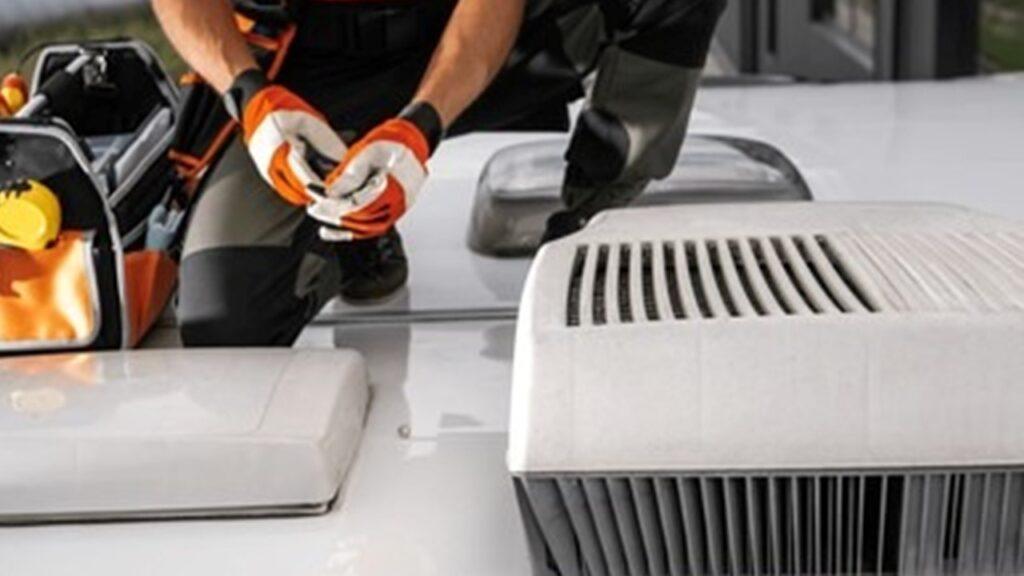
Keeping your RV air conditioner running smoothly often boils down to one thing: refrigerant. But how much refrigerant does an RV air conditioner need?
The answer depends on your AC’s size and model. If you’re like me—a campervan enthusiast who values staying cool on the road—you know that a well-functioning air conditioner can make or break a trip. In this article, I’ll break it all down, from what refrigerant is to how to check if your system needs a top-up.
What Is Refrigerant and Why Is It Important?
Refrigerant is a cooling agent that absorbs and releases heat, allowing your air conditioner to produce cold air. Without it, your RV AC won’t cool effectively, leaving you sweating in your campervan.
Why is it important? Because the right amount of refrigerant keeps your AC efficient, prevents overworking the compressor, and extends the unit’s lifespan.
Here’s why refrigerant matters:
- It’s the backbone of your AC’s cooling process.
- Too little refrigerant reduces cooling power.
- Too much refrigerant can damage the system.
How Much Refrigerant Does an RV Air Conditioner Need?
An RV air conditioner typically needs 2–4 pounds of refrigerant per ton of cooling capacity. For a standard RV AC unit, like a 13,500 BTU system, that translates to about 1.1–2.2 pounds of refrigerant.
Most RV air conditioners fall within this range, but it’s always smart to check the manufacturer’s guidelines for your specific model. The size of your unit plays a big role here. A larger AC unit, like a 15,000 BTU system, will need slightly more refrigerant than a smaller one.
Keep in mind, refrigerant isn’t something you top off casually. If your system is low, it might be leaking. This means you should fix the leak before adding more refrigerant.
Tools You’ll Need to Check Refrigerant Levels
Before you dive into checking your RV AC refrigerant, gather a few tools:
- Pressure gauge for measuring refrigerant pressure.
- Thermometer to monitor refrigerant temperature.
- Service port adapter for easy connection.
- Protective gloves and eyewear for safety.
How to Check the Refrigerant Level in Your RV Air Conditioner
Here’s how to check the refrigerant level in your RV AC:
- Connect a pressure gauge to the service port.
- Compare the pressure reading to the recommended range for your unit.
- If the pressure is off, consider professional help.
Step 1: Locate the Service Port
The service port is where you’ll connect your pressure gauge to check the refrigerant level. It’s usually found on the outdoor portion of your RV’s air conditioner unit. Depending on your model, you may need to remove an access panel or cover to reveal the service port.
Look for a small metal fitting with a cap labeled “low-pressure” or something similar. Make sure your RV is powered off before you begin for safety.
Step 2: Attach the Pressure Gauge
Take your pressure gauge and securely attach it to the service port. You’ll feel or hear a slight click when it locks into place. Ensure the connection is snug to prevent any refrigerant leaks during the process.
If you’re using an adapter, double-check that it’s compatible with your AC model and refrigerant type. This step is crucial for an accurate reading, so don’t rush it.
Step 3: Take a Pressure Reading
Once the gauge is securely attached, turn your campervan air conditioner on and let it run for a few minutes to stabilize. Check the gauge reading and compare it to the temperature-pressure chart for your specific refrigerant type (usually found in the manual or online).
The pressure will vary depending on the ambient temperature, so it’s important to account for this when interpreting the results.
Step 4: Evaluate the Results
After noting the pressure, compare it to the recommended range for your RV air conditioner. If the pressure is too low, it’s a sign that your system may be leaking refrigerant. Don’t just add refrigerant to “fix” the problem—leaks must be repaired first to prevent long-term damage.
If the pressure is normal, your refrigerant level is likely fine, and any cooling issues could stem from another cause, like a dirty filter or faulty compressor.
Safety Tips for Handling Refrigerant
Handling refrigerant comes with risks. Here’s how to stay safe:
- Wear protective gloves and goggles.
- Never release refrigerant into the air—it’s harmful to the environment.
- Work in a well-ventilated area.
- If unsure, leave it to a professional.
Signs Your RV Air Conditioner May Be Low on Refrigerant
Not sure if your AC needs refrigerant? Watch for these signs:
- Blowing warm air instead of cold.
- Reduced airflow from vents.
- Ice forming on the coils.
- Strange hissing or bubbling sounds.
- Higher energy bills than usual.
Why Proper Refrigerant Levels Matter for RVs
The right amount of refrigerant keeps your RV air conditioner efficient and prevents unnecessary wear. Low levels make the AC work harder, which can overheat the compressor and lead to expensive repairs. Too much refrigerant, on the other hand, puts extra pressure on the system, potentially damaging components.
It’s like your RV’s engine oil—too much or too little can cause problems. Regular checks and proper maintenance not only protect your AC but also keep your trips cool and worry-free.
How to Refill or Recharge Your RV Air Conditioner
Here’s how to refill or recharge your RV air conditioner:
- Step 1: Find the correct refrigerant type and quantity for your AC unit.
- Step 2: Connect the charging hose to the refrigerant can and service port.
- Step 3: Slowly add refrigerant while monitoring pressure levels.
- Step 4: Check for leaks and confirm proper cooling performance.
Step 1: Find the Correct Refrigerant Type and Quantity
Before adding anything, you need to know which refrigerant your air conditioner uses—common options include R-134a or R-410A. This information can usually be found in your RV manual or on the AC unit’s label. Using the wrong refrigerant can damage your system, so double-check to avoid costly mistakes.
Step 2: Connect the Charging Hose
Attach the charging hose to both the refrigerant canister and the low-pressure service port on your AC unit. Make sure the connections are secure to prevent leaks during the process. This is also a good time to wear gloves and goggles for safety since refrigerants can cause frost burns.
Step 3: Slowly Add Refrigerant
With the AC running, open the valve on the canister and allow the refrigerant to flow into the system gradually. Use a pressure gauge to monitor the levels and stop when they fall within the recommended range. Adding refrigerant too quickly can lead to overcharging, so take your time with this step.
Step 4: Check for Leaks and Performance
After adding refrigerant, inspect the system for any leaks around the connections or hoses. Let the AC run for a while and check if it’s blowing cold air as it should. If you still experience issues, it might be time to call a professional.
Maintenance Tips to Prevent Refrigerant Loss in RVs
Keeping your RV air conditioner in good shape reduces the chances of refrigerant loss. Here are a few tips:
- Inspect your AC unit regularly for wear and tear.
- Clean or replace air filters to prevent clogging.
- Tighten loose connections and check for leaks.
- Schedule annual maintenance with a professional technician.
- Avoid running the AC with damaged components or unusual noises.
DIY vs. Professional Servicing: Which Is Better?
Deciding between DIY and professional servicing depends on your experience and confidence. DIY can save money and teach you new skills, but mistakes like overfilling or using the wrong refrigerant can cause costly damage.
Professionals have the tools and expertise to handle complex issues, like leaks or worn components, that you might miss.
While it costs more, professional servicing is often the smarter choice for peace of mind and long-term reliability, especially if you’re unsure about working with refrigerants.
Conclusion
Understanding how much refrigerant your RV air conditioner needs can save you from costly repairs and uncomfortable trips. Typically, RV AC units require 2–4 pounds of refrigerant per ton of cooling capacity, but it’s always best to check your specific model’s guidelines.
Regular maintenance, knowing how to check refrigerant levels, and addressing leaks early are all key to keeping your AC in top shape. With the right care, your air conditioner will keep you cool and comfortable, no matter where your adventures take you.
FAQs
Can I overfill my RV air conditioner with refrigerant?
Yes, and it’s not a good idea. Overfilling can increase pressure in the system, potentially damaging components like the compressor. Always follow the recommended refrigerant levels for your unit.
How often does refrigerant need to be refilled?
Refrigerant doesn’t typically need to be refilled unless there’s a leak. If your AC isn’t cooling well, check for leaks and address them before adding more refrigerant.
What are the costs of recharging refrigerant?
The cost varies depending on the refrigerant type and whether you do it yourself or hire a professional. DIY kits can range from $30–$100, while professional services may cost $150–$300 or more.
Are there alternatives to traditional refrigerants?
Yes, newer refrigerants like R-410A and R-32 are more environmentally friendly than older types like R-22, which is being phased out. Always use the refrigerant specified for your AC to avoid damage.
As outdoor enthusiasts ourselves, we understand the significance of reliable gear that can withstand the elements and support you throughout your journey. We try to provide as much real life information with our guides and how tos to the readers as possible. Our honest and transparent reviews of essential outdoor gadgets and products are rooted in testing and experience. We take great satisfaction in offering unbiased evaluations, ensuring that you can make informed decisions when investing in outdoor gear. As an affiliate website, we may earn a small commission from some of the products we feature. However, rest assured that our opinions are not influenced by this, and your trust is always our top priority.



